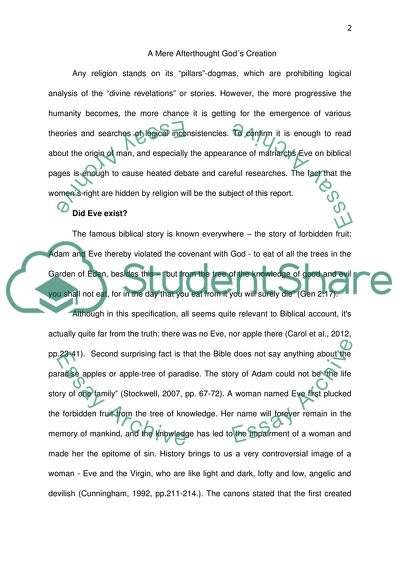Cite this document
(A Mere Afterthought God`s Creation Report Example | Topics and Well Written Essays - 2500 words, n.d.)
A Mere Afterthought God`s Creation Report Example | Topics and Well Written Essays - 2500 words. https://studentshare.org/religion-and-theology/1858749-consider-whether-sources-in-genesis-suggest-that-eve-was-a-mere-afterthought-and-reflect-on-the-reception-of-the-creation-of-woman-in-early-christian-andor-subsequent-rabbinic-traditions
A Mere Afterthought God`s Creation Report Example | Topics and Well Written Essays - 2500 words. https://studentshare.org/religion-and-theology/1858749-consider-whether-sources-in-genesis-suggest-that-eve-was-a-mere-afterthought-and-reflect-on-the-reception-of-the-creation-of-woman-in-early-christian-andor-subsequent-rabbinic-traditions
(A Mere Afterthought God`s Creation Report Example | Topics and Well Written Essays - 2500 Words)
A Mere Afterthought God`s Creation Report Example | Topics and Well Written Essays - 2500 Words. https://studentshare.org/religion-and-theology/1858749-consider-whether-sources-in-genesis-suggest-that-eve-was-a-mere-afterthought-and-reflect-on-the-reception-of-the-creation-of-woman-in-early-christian-andor-subsequent-rabbinic-traditions.
A Mere Afterthought God`s Creation Report Example | Topics and Well Written Essays - 2500 Words. https://studentshare.org/religion-and-theology/1858749-consider-whether-sources-in-genesis-suggest-that-eve-was-a-mere-afterthought-and-reflect-on-the-reception-of-the-creation-of-woman-in-early-christian-andor-subsequent-rabbinic-traditions.
“A Mere Afterthought God`s Creation Report Example | Topics and Well Written Essays - 2500 Words”. https://studentshare.org/religion-and-theology/1858749-consider-whether-sources-in-genesis-suggest-that-eve-was-a-mere-afterthought-and-reflect-on-the-reception-of-the-creation-of-woman-in-early-christian-andor-subsequent-rabbinic-traditions.


